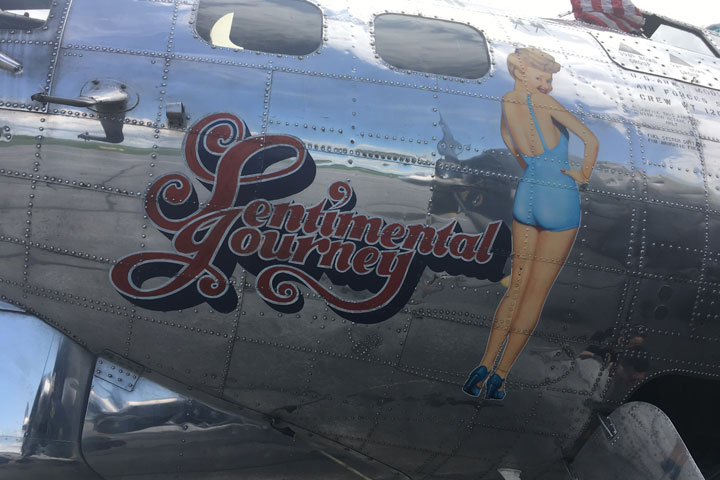On Monday, I sat sweating in the intense afternoon heat, strapped into a tiny chair in the wireless radio room aboard a 73-year-old B-17 bomber just outside Kingston, Ont., and all I could think about was Abraham Wald, an Austro-Hungarian Jew with a knack for mathematics.

You know what? I’m probably going to need to explain this better.
The bomber was the Sentimental Journey. She was built in 1944 for service in the Second World War and served in the Pacific Theatre as a reconnaissance aircraft, never seeing combat. Today, she’s one of the many Second World War-era aircraft operated by the Commemorative Air Force, a charitable foundation out of Texas that acquires, restores and — when possible — flies Second World War-era planes.
The plane had come to Kingston, Ont., as part this year’s summer air show season. As a broadcaster and columnist with a love of military history, I was invited to visit and even go aboard with her crew for a spin out over the city and Lake Ontario.
I needed all of about 0.68 seconds to say, “Yes.”
Partially because of the historical significance of the B-17. They weren’t the most advanced planes operated by the Allies during the conflict, but they were workhorses. The Americans built an astonishing number of them — just shy of 13,000. The planes, dubbed Flying Fortresses thanks to their heavy defensive armament of machine guns, became symbols of American power.
But there’s also a bit of family history. I never knew my paternal grandfather, John M. Gurney. He died before I was born. But I certainly am aware of his wartime service. He flew in the Royal Canadian Air Force as a wireless air gunner and then, later, as a flying officer. He never flew in B-17s, but certainly did time in comparable aircraft — primarily B-24 Liberators and C-47 Dakotas. I couldn’t refuse the chance to see, even briefly, the world as he once had.
Strangely, though, even as we sat on the runway in Kingston, with my eyes resting on a vintage radio set very similar to the one he would have operated (when not firing the machine guns), my mind didn’t turn to family history at all. It turned to a man few will have heard of today, and the tough choice he made about the lives of men like my grandfather.
His name was Abraham Wald. Born Jewish in Austro-Hungary (and educated in Austria), he was raised by intellectually gifted and religiously observant parents. When the Nazis took over Austria in the leadup to the war, Wald was already working in the United States and was able to find safety there from religious oppression (and eventual likely annihilation). When America went to war in 1941, Wald was a professor at Columbia University in New York City. That’s where he joined the Statistical Research Group, a classified part of the American war effort that tried to bring mathematical and statistical rigour to the chaos of war.
WATCH: WWII bomber lands at Peterborough Airport

One of their projects was examining battle damage inflicted on U.S. aircraft. The military wanted to add armour to the planes, but that meant tradeoffs: it would slow planes down, make them less manoeuvrable and reduce the operational range. Ideally, you’d only put armour where it would make the most difference.
The U.S. military had diligently tracked damage by aircraft section (engines, wings, fuselage, etc.) and then calculated hits per square foot. The numbers were pretty clear: by far the most badly shot-up section of the damaged planes returning from battle was the fuselage. The military concluded that’s where the armour should go.
Wald disagreed. His insight was brilliant and is still widely cited in research today (which is how I’ve heard of it). Wald realized that since the military was only able to examine those planes that made it back to base, focusing on the areas with maximum damage was actually exactly wrong.
The fact that American (and Allied) aircraft were returning to base with massive damage to their fuselages wasn’t proof that the fuselages were the problem, it was proof that they weren’t — the fuselages were actually the part of the plane that could take the most damage without crashing. Wald flipped the military’s conclusion on its head: he wanted to know where surviving planes showed the least damage because he felt that that would reveal where a plane couldn’t be hit without going down.
The numbers were already there: relatively few planes with damaged engines were making it back to a friendly base. The conclusion? Planes that were hit in the fuselage survived long enough to return, planes hit in the engines were lost, along with their crews. So that’s where the armour was added. Wald’s insight contributed to allied warplane design for generations and saved an unknowable number of crews.
Wald’s contribution to the war effort came to mind as I rested my hand against the side of the Sentimental Journey’s fuselage. The plane’s hull is only a thin shell of aluminum. In the midday sun, it was hot to the touch. There was absolutely nothing that would stop a bullet or fragments from exploding anti-aircraft shells, and thanks to Wald’s decision, there wouldn’t be. Men like my grandfather went up in those planes at the mercy of not just the enemy, but statistics. The lives of individual aircrew in their cabins wouldn’t be protected by armour, but the plane itself and the crew as a whole would hopefully survive. The grim calculus of total war.
The B-17s didn’t last as combat aircraft much after the war. They were displaced by superior heavy bombers, notably the afore-mentioned B-24s and, later, the B-29 bombers that took the air war (including atomic bombs) to Japan.
But as we soared through the air over Kingston, deafened by the roar of the four engines and breathing the exhaust, I couldn’t help but be awed. The B-17 represents the absolute pinnacle of our industrial age technology, a perfect piece of mechanical equipment with very little electronic technology aboard. There are a few radios aboard, some interior and exterior lights. But the electronics we take utterly for granted today (and that began to enter military service by the war’s end) are generally not to be found.
The B-17 was a killing machine and it did its job well. But it’s also a symbol of human genius and the courage of the men who flew it. Not to mention the industrial power of the war effort that churned out B-17s and similar planes literally by the hundreds of thousands.
We couldn’t do that today, and we don’t wage war that way anymore. It’s probably a good thing. But I understand why the men and women at the Commemorative Air Force feel the urge to keep these old warbirds flying. There’s something magical about the human creativity and sacrifice they represent.
That sense of wonder is a peacetime luxury, of course, and not something my grandfather and his peers could enjoy. I’m grateful to him, and his generation, for the sacrifices they made to give me that luxury. And I’m grateful, profoundly and sincerely, to the Commemorative Air Force for taking me on one hell of a ride.
Matt Gurney is host of The Morning Show on Toronto’s Talk Radio AM640 and a columnist for Global News.









Comments